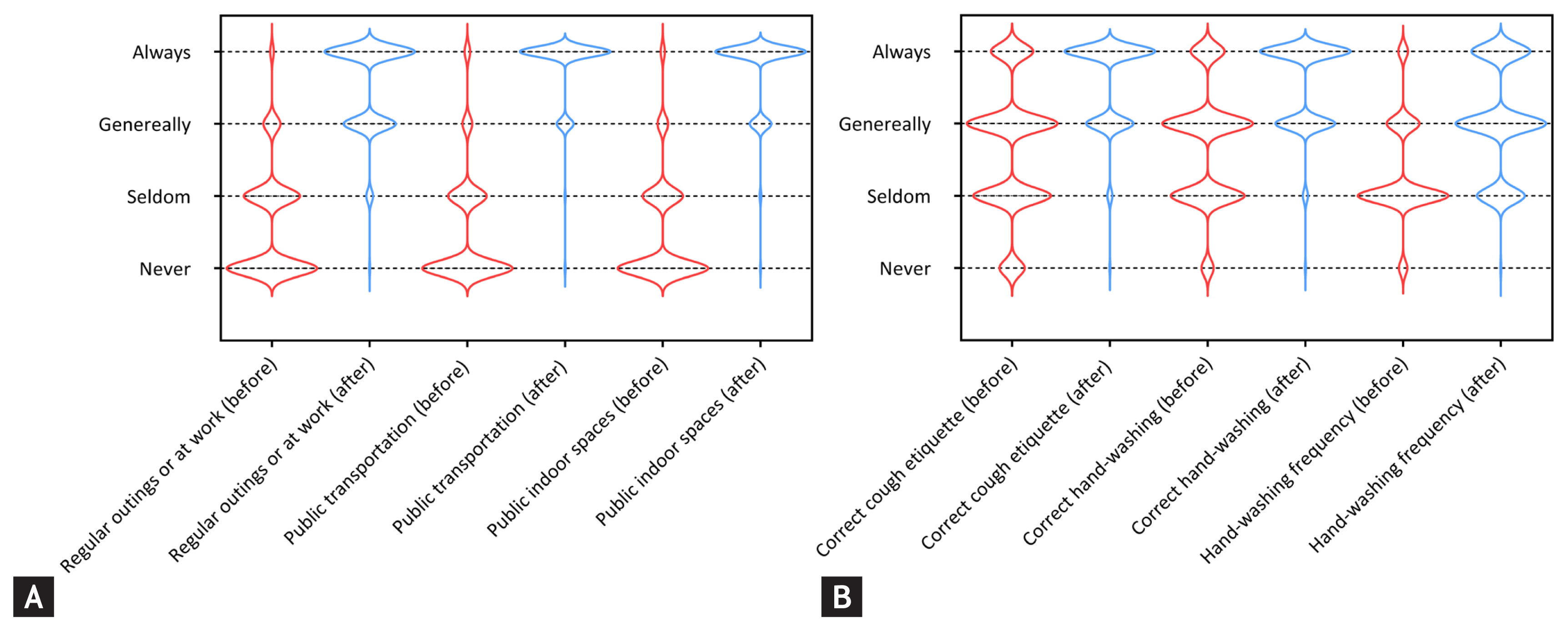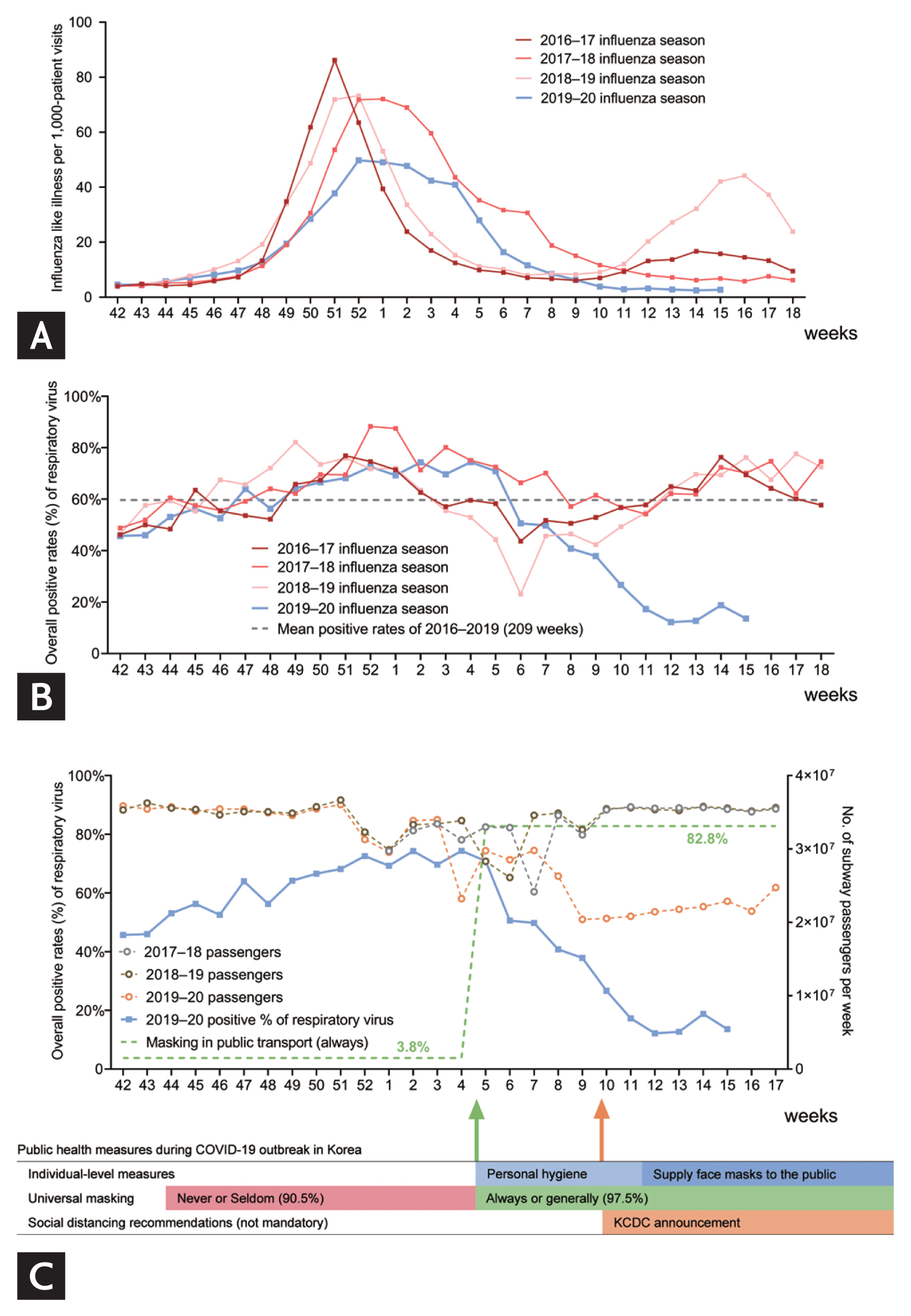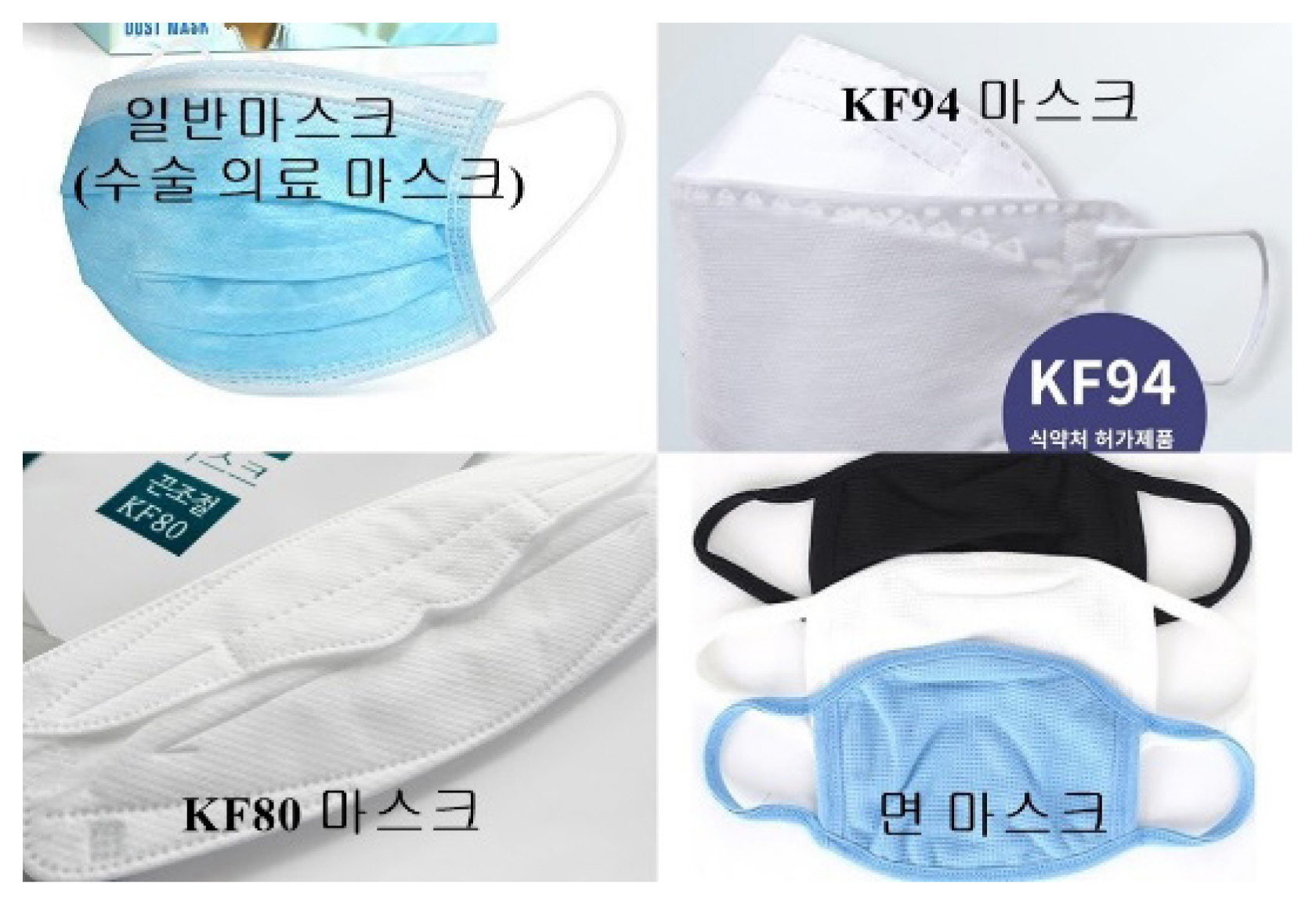 |
 |
|
|
|
Abstract
Background/Aims
Methods
Results
Supplementary Information
Supplementary Table 1.
Supplementary Table 2.
Supplementary Table 3.
Supplementary Table 4.
Supplementary Table 5.
Supplementary Figure 1.
Supplementary Figure 2.
Conflict of Interest
Acknowledgments
Figure 1

Figure 2

Figure 3

Table 1
| Question | Response frequency (n = 604) | p valueb | |
|---|---|---|---|
|
Before COVID-19 2019.12–2020.1a |
After COVID-19 2020.2–2020.3a |
||
| Characteristics | |||
| Female sex | 364 (60.3) | ||
| Health-care worker | 39 (6.5) | ||
| Age group, yr | |||
| 18–29 | 77 (12.7) | ||
| 30–39 | 153 (25.3) | ||
| 40–49 | 142 (23.5) | ||
| 50–59 | 168 (27.8) | ||
| 60–69 | 52 (8.6) | ||
| ≥ 70 | 12 (2.0) | ||
| Perception of the use of masks | |||
| It is necessary to wear a mask regularly to protect myself against the virus (yes) | 584 (96.7) | ||
| People wearing masks may be patients (yes) | 17 (2.8) | ||
| The reasons for using masks | |||
| For personal protection from the infection | 514 (85.1) | ||
| To prevent transmission of infection to people around them | 401 (66.4) | ||
| Because everyone else wears them and they did not want to be singled out for not wearing them | 121 (20.0) | ||
| It is necessary in the work setting | 90 (14.9) | ||
| Preventive measuresc | |||
| Wearing a mask during regular outings or at work | 1.60 ± 0.76 | 3.54 ± 0.61 | < 0.001 |
| Wearing a mask in public transportation (n = 598)d | 1.52 ± 0.78 | 3.80 ± 0.48 | < 0.001 |
| Wearing a mask in public indoor spaces with other people | 1.51 ± 0.75 | 3.75 ± 0.52 | < 0.001 |
| Adhering to correct cough etiquettee | 2.63 ± 0.90 | 3.58 ± 0.59 | < 0.001 |
| Adhering to correct hand-washinge | 2.69 ± 0.80 | 3.53 ± 0.60 | < 0.001 |
| Score for correct hand-washing practicef | 2.31 ± 0.68 | 3.04 ± 0.75 | < 0.001 |
a For the survey, the cut-off day for the COVID-19 pandemic was defined as January 31, 2020. On January 27, the national infectious disease alert level went from ‘caution’ to ‘alert.’
b The mask use and personal hygiene practice before and after the COVID-19 pandemic were compared by paired t test.
c Likert scale responses: “Never,” “Seldom,” “Generally,” and “Always.” Depending on the level of use, the question was scored from 1 for “Never” to 4 for “Always.”
d Data were missing for six patients. Except for this item, all respondents had to complete the mandatory answers when proceeding with the online surveys and submit the final responses. The responses of the respondents who stopped in the middle of the questionnaire could not be collected.
Table 2
| Variable | Years of influenza seasons | ||||
|---|---|---|---|---|---|
| 2016–2017 | 2017–2018 | 2018–2019 | 2019–2020 | p value | |
| Duration of epidemics, wka | 14 (influenza A) | 19 | 14 (influenza A) | 16 | - |
| Duration of epidemic phases, wkb | |||||
| Exacerbation phase | 4 | 6 | 6 | 13 | 0.002c |
| Relief phase | 10 | 13 | 8 | 3 | |
| Alleviation rates of seasonal epidemics | |||||
| Mean positive reduction rate per week, % | −4.85 | −4.81 | −4.92 | −9.20 | 0.995d |
| Mean reduction in no. of patients per week, % | −13.5 | −13.5 | −18.3 | −34.0 | 0.452d |
a The period of the epidemic was between when the test positivity of influenza increased by ≥ 5% to the week before it fell to < 5%.
Table 3
| Year or influenza season | Duration, wk | Total | Total positive rate, % | p valueb | Positive rate for individual respiratory virusa | |||||
|---|---|---|---|---|---|---|---|---|---|---|
| HCoV, % | HRV, % | HPIV, % | HMPV, % | HAdV, % | IFV, % | |||||
| 2016 | 53 | 11,111 | 59.0 | - | 5.5 | 15.0 | 6.0 | 4.1 | 6.3 | 15.9 |
| 2017 | 52 | 11,915 | 56.6 | - | 4.4 | 19.4 | 6.3 | 5.3 | 3.7 | 10.9 |
| 2018 | 52 | 11,966 | 63.0 | - | 5.7 | 16.3 | 6.1 | 4.9 | 6.8 | 17.0 |
| 2019 | 52 | 12,151 | 60.2 | - | 2.9 | 17.2 | 6.4 | 5.0 | 8.0 | 14.0 |
| 2016–17 | Post-epidemic, 8c | 1,702 | 47.7 | 0.002 | 2.2 | 18.0 | 14.5 | 1.3 | 4.9 | 1.7 |
| 2017–18 | Post-epidemic, 8c | 1,868 | 69.9 | < 0.001 | 2.1 | 25.1 | 10.8 | 17.3 | 5.4 | 2.9 |
| 2018–19 | Post-epidemic, 8c | 1,563 | 67.6 | < 0.001 | 1.2 | 20.2 | 18.2 | 6.9 | 9.3 | 1.3 |
| 2019–20 | Post-epidemic, 8c | 845 | 26.5 | NA | 4.3 | 6.4 | 0.2 | 2.6 | 6.6 | 1.3 |
HCoV, human coronavirus; HRV, human rhinovirus; HPIV, human parainfluenza virus types; HMPV, human metapneumovirus; HAdV, human adenovirus; IFV, influenza virus; NA, not available.
a HPIV (human parainfluenza virus types 1, 2, and 3), HRSV (human respiratory syncytial virus types A and B), IFV (influenza A/H1N1(pdm09) and A/H3N2 B), HCoV (human coronavirus 229E, OC43, and NL63).
REFERENCES
APPENDICES
APPENDIX 1
Online questionnaire
-
#1. What is your sex?
Male / Female -
#2. What is your age?
18 – 29 / 30 – 39 / 40 – 49 / 50 – 59 /60 – 69 / ≥ 70 -
#3. Are you a health-care worker (hospital or clinics, all kinds of workers)?
Yes / No -
#4. Do you think it is necessary to wear a mask regularly to protect yourself against the virus?
Yes/ No -
#5. Do you think people wearing masks may be sick patients?
Yes / NoWe will ask the same questions for ‘before’ and ‘during the COVID-19 epidemic.’ Please answer separately. The questions below require one response per row.The period before the COVID-19 epidemic: from December 2019 to January 2020.The period during and after the COVID-19 epidemic: from February 2020 to March 2020. -
#6. Overall, did you wear a mask during regular outings or at work?
Before epidemic: a. Never b. Seldom c. Generally d. AlwaysAfter epidemic: a. Never b. Seldom c. Generally d. Always -
#7. Did you wear a mask in public transportation?
Before epidemic: a. Never b. Seldom c. Generally d. AlwaysAfter epidemic: a. Never b. Seldom c. Generally d. Always -
#8. Did you wear a mask in public indoor spaces with other people?
Before epidemic: a. Never b. Seldom c. Generally d. AlwaysAfter epidemic: a. Never b. Seldom c. Generally d. Always -
#9. Which masks did you most use?
Before epidemic: a. Surgical mask b. KF94 c. KF80 d. Cotton mask e. OthersAfter epidemic: a. Surgical mask b. KF94 c. KF80 d. Cotton mask e. Others -
#10. Why did you use masks during the COVID-19 epidemic? (multiple choices are possible.)
-
#11. Did you adhere to proper cough etiquette?
[Proper Coughing Etiquette]Cover your mouths and nose with a tissue or your sleeve when coughing or sneezing. Wash your hands with soap after coughing or use a hand sanitiser.Before epidemic: a. Never b. Seldom c. Generally d. AlwaysAfter epidemic: a. Never b. Seldom c. Generally d. Always -
#12. Did you adhere to correct hand-washing?
[Proper Wand-washing]Wash your hands with running water and soap for at least 30 seconds. You could use an alcohol-based hand sanitiser. Palms - Backs of the hands - Between the fingers - Fingers interlocked - Thumbs - Under the nailsBefore epidemic: a. Never b. Seldom c. Generally d. AlwaysAfter epidemic: a. Never b. Seldom c. Generally d. Always -
#13. How many times a day did you do accurate and correct hand-washing?
Before epidemic: a. 0 b. 1 – 5 c. 6 – 10 d. >10After epidemic: a. 0 b. 1 – 5 c. 6 – 10 d. >10
APPENDIX 2
Summary of the COVID-19 epidemic in South Korea
- TOOLS
-
METRICS

- Related articles
-
Incidence of rheumatic diseases during the COVID-19 pandemic in South Korea2023 March;38(2)





 PDF Links
PDF Links PubReader
PubReader ePub Link
ePub Link Full text via DOI
Full text via DOI Download Citation
Download Citation Supplement 1
Supplement 1 Print
Print


